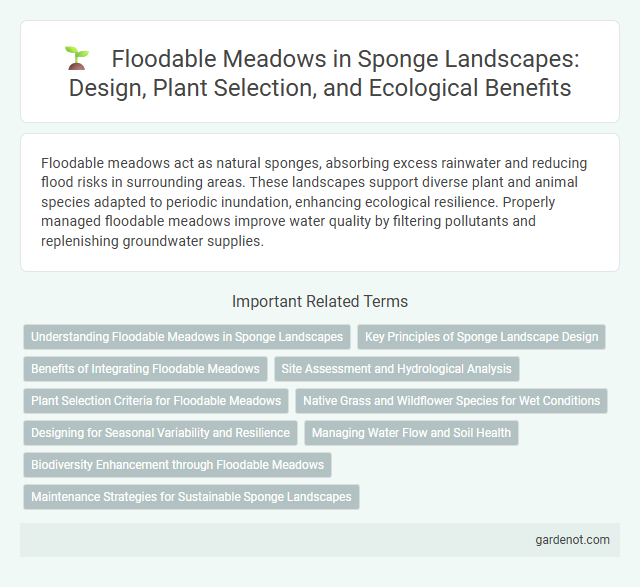Floodable meadows act as natural sponges, absorbing excess rainwater and reducing flood risks in surrounding areas. These landscapes support diverse plant and animal species adapted to periodic inundation, enhancing ecological resilience. Properly managed floodable meadows improve water quality by filtering pollutants and replenishing groundwater supplies.
Understanding Floodable Meadows in Sponge Landscapes
Floodable meadows play a crucial role in sponge landscapes by absorbing excess rainwater and reducing flood risks. These meadows consist of specialized vegetation and soil structures that enhance water retention and slow runoff, promoting groundwater recharge. Effective management of floodable meadows supports biodiversity while improving landscape resilience against extreme weather events.
Key Principles of Sponge Landscape Design
Floodable meadows in sponge landscape design prioritize natural water retention through permeable soil layers and native vegetation that enhances infiltration. Key principles include maximizing surface roughness to slow runoff, creating microtopography for temporary water storage, and integrating flood-tolerant plant species to maintain ecosystem resilience. These design elements collectively improve groundwater recharge, reduce flood risk, and support biodiversity within urban and rural settings.
Benefits of Integrating Floodable Meadows
Integrating floodable meadows into sponge landscape designs enhances natural water retention and reduces urban flooding risks by absorbing excess stormwater. These meadows support biodiversity by creating habitats for various plant and animal species, contributing to ecological resilience. Incorporating floodable meadows also improves water quality through natural filtration, mitigating pollutants before they reach waterways.
Site Assessment and Hydrological Analysis
Floodable meadows require comprehensive site assessment to evaluate soil permeability, topography, and existing vegetation, ensuring optimal water retention and biodiversity support. Hydrological analysis involves monitoring groundwater levels, surface runoff patterns, and seasonal precipitation to design interventions that enhance natural flood mitigation. Integrating these assessments guides the implementation of sponge landscape techniques that reduce flood risks and improve ecosystem resilience.
Plant Selection Criteria for Floodable Meadows
Plant selection criteria for floodable meadows prioritize species with high tolerance to prolonged inundation and waterlogged soils, such as sedges (Carex spp.) and rushes (Juncus spp.). Native hydrophytic plants that promote soil stabilization and enhance biodiversity include flood-tolerant grasses like Glyceria maxima and wetland forbs like Lysimachia thyrsiflora. Choosing drought-resistant and deep-rooted species helps maintain resilience during fluctuating water levels, optimizing ecological function and habitat quality in sponge landscape floodable meadows.
Native Grass and Wildflower Species for Wet Conditions
Floodable meadows thrive with native grass species such as Carex vulpinoidea (fox sedge) and Panicum virgatum (switchgrass), which are adapted to periodic inundation and saturated soils. Wildflower species like Asclepias incarnata (swamp milkweed) and Lobelia cardinalis (cardinal flower) provide vital nectar sources while tolerating wet conditions and supporting local biodiversity. These plants enhance soil stabilization, water filtration, and habitat connectivity in sponge landscape designs focused on flood mitigation.
Designing for Seasonal Variability and Resilience
Floodable meadows enhance sponge landscapes by incorporating native vegetation adapted to fluctuating water levels, improving seasonal water retention and biodiversity. Designing these meadows with graded topography and permeable soil substrates allows efficient absorption during wet seasons and drought resilience during dry periods. Integrating floodable meadows supports natural flood mitigation and groundwater recharge, promoting ecosystem stability and climate resilience.
Managing Water Flow and Soil Health
Floodable meadows enhance sponge landscapes by absorbing excess rainwater, reducing flood risks downstream and promoting groundwater recharge. Their diverse vegetation slows water flow, preventing soil erosion while maintaining rich organic matter that improves soil structure and fertility. Effective management includes periodic mowing and controlled grazing to sustain plant health and maximize water retention capacity.
Biodiversity Enhancement through Floodable Meadows
Floodable meadows play a crucial role in biodiversity enhancement by providing seasonal wetlands that support diverse plant and animal species adapted to periodic flooding. These habitats improve ecosystem resilience, offering breeding grounds for amphibians, birds, and insects while promoting native vegetation growth. Integrating floodable meadows into sponge landscape designs supports ecological connectivity and increases overall habitat heterogeneity.
Maintenance Strategies for Sustainable Sponge Landscapes
Floodable meadows require regular mowing schedules and debris removal to maintain soil permeability and prevent waterlogging. Integrating native vegetation supports natural water absorption and enhances biodiversity, while adaptive management ensures resilience to seasonal flooding variations. Monitoring soil moisture and water flow patterns optimizes maintenance efforts, sustaining the meadow's role in sponge landscape functionality.
Floodable meadow Infographic

 gardenot.com
gardenot.com